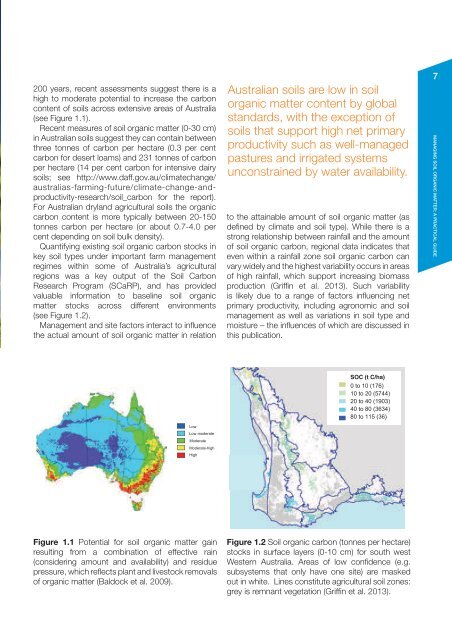managing soil organic matter - Grains Research & Development ...
managing soil organic matter - Grains Research & Development ...
managing soil organic matter - Grains Research & Development ...
Create successful ePaper yourself
Turn your PDF publications into a flip-book with our unique Google optimized e-Paper software.
200 years, recent assessments suggest there is ahigh to moderate potential to increase the carboncontent of <strong>soil</strong>s across extensive areas of Australia(see Figure 1.1).Recent measures of <strong>soil</strong> <strong>organic</strong> <strong>matter</strong> (0-30 cm)in Australian <strong>soil</strong>s suggest they can contain betweenthree tonnes of carbon per hectare (0.3 per centcarbon for desert loams) and 231 tonnes of carbonper hectare (14 per cent carbon for intensive dairy<strong>soil</strong>s; see http://www.daff.gov.au/climatechange/australias-farming-future/climate-change-andproductivity-research/<strong>soil</strong>_carbonfor the report).For Australian dryland agricultural <strong>soil</strong>s the <strong>organic</strong>carbon content is more typically between 20-150tonnes carbon per hectare (or about 0.7-4.0 percent depending on <strong>soil</strong> bulk density).Quantifying existing <strong>soil</strong> <strong>organic</strong> carbon stocks inkey <strong>soil</strong> types under important farm managementregimes within some of Australia’s agriculturalregions was a key output of the Soil Carbon<strong>Research</strong> Program (SCaRP), and has providedvaluable information to baseline <strong>soil</strong> <strong>organic</strong><strong>matter</strong> stocks across different environments(see Figure 1.2).Management and site factors interact to influencethe actual amount of <strong>soil</strong> <strong>organic</strong> <strong>matter</strong> in relationAustralian <strong>soil</strong>s are low in <strong>soil</strong><strong>organic</strong> <strong>matter</strong> content by globalstandards, with the exception of<strong>soil</strong>s that support high net primaryproductivity such as well-managedpastures and irrigated systemsunconstrained by water availability.to the attainable amount of <strong>soil</strong> <strong>organic</strong> <strong>matter</strong> (asdefined by climate and <strong>soil</strong> type). While there is astrong relationship between rainfall and the amountof <strong>soil</strong> <strong>organic</strong> carbon, regional data indicates thateven within a rainfall zone <strong>soil</strong> <strong>organic</strong> carbon canvary widely and the highest variability occurs in areasof high rainfall, which support increasing biomassproduction (Griffin et al. 2013). Such variabilityis likely due to a range of factors influencing netprimary productivity, including agronomic and <strong>soil</strong>management as well as variations in <strong>soil</strong> type andmoisture – the influences of which are discussed inthis publication.7MANAGING SOIL ORGANIC MATTER: A PRACTICAL GUIDEFigure 1.1 Potential for <strong>soil</strong> <strong>organic</strong> <strong>matter</strong> gainresulting from a combination of effective rain(considering amount and availability) and residuepressure, which reflects plant and livestock removalsof <strong>organic</strong> <strong>matter</strong> (Baldock et al. 2009). Figure 1.2 Soil <strong>organic</strong> carbon (tonnes per hectare)stocks in surface layers (0-10 cm) for south westWestern Australia. Areas of low confidence (e.g.subsystems that only have one site) are maskedout in white. Lines constitute agricultural <strong>soil</strong> zones:grey is remnant vegetation (Griffin et al. 2013).
















